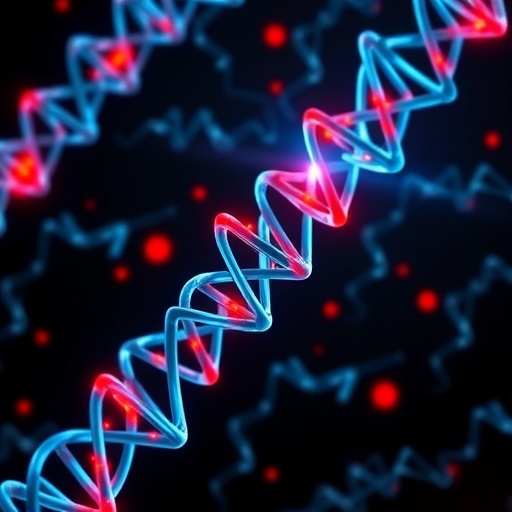Researchers at the University of Bath have made a significant breakthrough in understanding the molecular underpinnings of Motor Neurone Disease (MND), also referred to as Amyotrophic Lateral Sclerosis (ALS). This neurodegenerative disorder, characterized by relentless loss of motor neurones that command muscle movement, has long baffled scientists due to its multifactorial and largely unknown etiology. By focusing on the role of faulty DNA repair mechanisms linked to mutations in CFAP410, the researchers have elucidated a new dimension that could potentially redefine therapeutic strategies against this devastating disease.
MND impacts a small but steadily increasing segment of the global population, affecting between three to five individuals per 100,000 annually. Despite decades of research, pinpointing a definite cause has remained elusive. Prior investigations had indicated several genetic anomalies potentially associated with MND, and notably, mutations in the gene coding for CFAP410 drew attention as a possible contributor. However, the biological pathways connecting CFAP410 dysfunction to neuronal degradation remained unclear until now.
CFAP410 encodes for a protein localized predominantly on the cell surface structures known as cilia, which are microscopic, hair-like organelles that orchestrate various pivotal cellular signaling cascades. These signaling pathways critically influence brain development and cellular responses to environmental cues. Besides its role in cilia, CFAP410 appears to have a hitherto underappreciated involvement in the safeguarding of genomic integrity by regulating DNA damage response (DDR) mechanisms within motor neurones.
Utilizing the advanced precision of gene editing technologies, particularly CRISPR-Cas9, the Bath team introduced specific patient-derived mutations of CFAP410 into mouse embryonic stem cells. This approach allowed them to simulate the mutational landscape observed in MND patients within a controlled laboratory environment. Subsequent differentiation of these stem cells into mature motor neurones provided a biological platform to assess the effect of CFAP410 perturbations on neuron viability, cilia morphology, and genomic maintenance under stress conditions.
A striking revelation emerged when the scientists observed that, contrary to complete gene knockout models which resulted in defective cilia formation, motor neurones harboring the CFAP410 mutations preserved the structural integrity of their cilia. This finding challenged the conventional assumption that cilia dysfunction was the primary pathological driver in CFAP410-related MND, shifting the investigative lens towards other cellular processes potentially compromised by these genetic variants.
Further biochemical analysis revealed that mutated CFAP410 disrupted its interaction with Nek1, a serine/threonine kinase pivotal for activating the DNA damage repair machinery within cells. Nek1’s role in coordinating the cellular response to double-strand breaks and other genotoxic stresses places it at the heart of maintaining neuronal survival when confronted with endogenous and exogenous insults. The perturbation of CFAP410-Nek1 interaction, therefore, compromised the neurones’ ability to effectively sense and repair DNA damage.
This impairment in the DNA damage response manifested as enhanced vulnerability of the mutated motor neurones to chemical stressors known to induce genomic lesions. The neurons exhibited prolonged unrepaired DNA breaks, elevated markers of cellular apoptosis, and ultimately increased rates of cell death. This cascade delineates a mechanistic pathway wherein faulty DNA repair, instigated by CFAP410 mutations, accelerates motor neuron degradation characteristic of MND.
Published in the esteemed journal iScience, the study offers critical insights into the cell-autonomous processes contributing to motor neurone loss. By establishing DNA damage accumulation and defective repair as central contributors to MND pathogenesis, the research pivots away from purely developmental or structural explanations, instead highlighting cellular maintenance failures as a crucial nexus for intervention.
Dr. Vasanta Subramanian, leading the research team at the University of Bath’s Department of Life Sciences, emphasized the translational potential of these findings. Given the current lack of curative treatments for MND and its rising global incidence, identifying molecular vulnerabilities amenable to therapeutic targeting could transform patient outcomes. The data suggest that augmenting DNA repair pathways or developing compounds that shield motor neurones from genotoxic stress may represent viable therapeutic avenues moving forward.
Beyond therapeutic implications, the research also underscores the importance of studying protein-protein interactions within the DDR cascade. The CFAP410-Nek1 interplay exemplifies how subtle disruptions in signaling complexes can precipitate catastrophic neuronal consequences. Such mechanistic insights broaden our understanding of neurodegeneration and may find resonance in other age-related neurological disorders marked by genomic instability.
The University of Bath team is poised to extend these findings by dissecting the downstream molecular events following CFAP410 mutation-induced Nek1 dysfunction. This future work aims to unravel the precise signaling networks and repair enzymes affected, ultimately informing the rational design of targeted gene or drug therapies. The integration of molecular genetics, cell biology, and neurobiology in this research highlights a multidisciplinary approach essential for tackling complex diseases such as MND.
As the scientific community rallies to decode the intricate choreography of DNA repair in neurons, the Bath study serves as a compelling reminder that preserving genomic integrity is paramount to neuronal health. This investigation spotlights a novel disease mechanism—one where DNA repair perturbations, rather than classical developmental defects, drive neurodegeneration, offering a fresh and hopeful perspective on combating ALS.
In summary, the identification of functional CFAP410 variants as modulators of the DNA damage response and their consequent role in motor neuron demise represents a paradigm shift in our understanding of MND pathology. This work not only enhances our molecular grasp of ALS but also opens promising pathways for the development of innovative treatments aimed at stabilizing the genome and prolonging neuron survival in affected individuals.
Subject of Research: Cells
Article Title: Functional variants of CFAP410 affect the DNA damage response leading to motor neuron degeneration – Implications for ALS
News Publication Date: 19-Sep-2025
References:
DOI: 10.1016/j.isci.2025.113338
Keywords: Amyotrophic lateral sclerosis, Neurological disorders, Motor neurons, Gene editing, Mutational analysis, DNA repair, DNA damage, DNA damage responses




